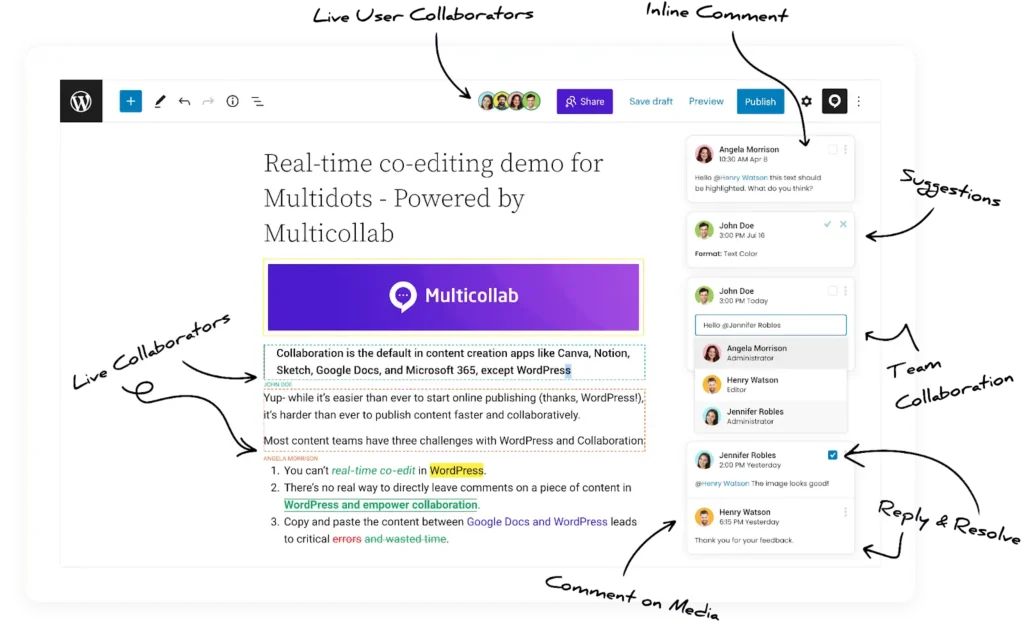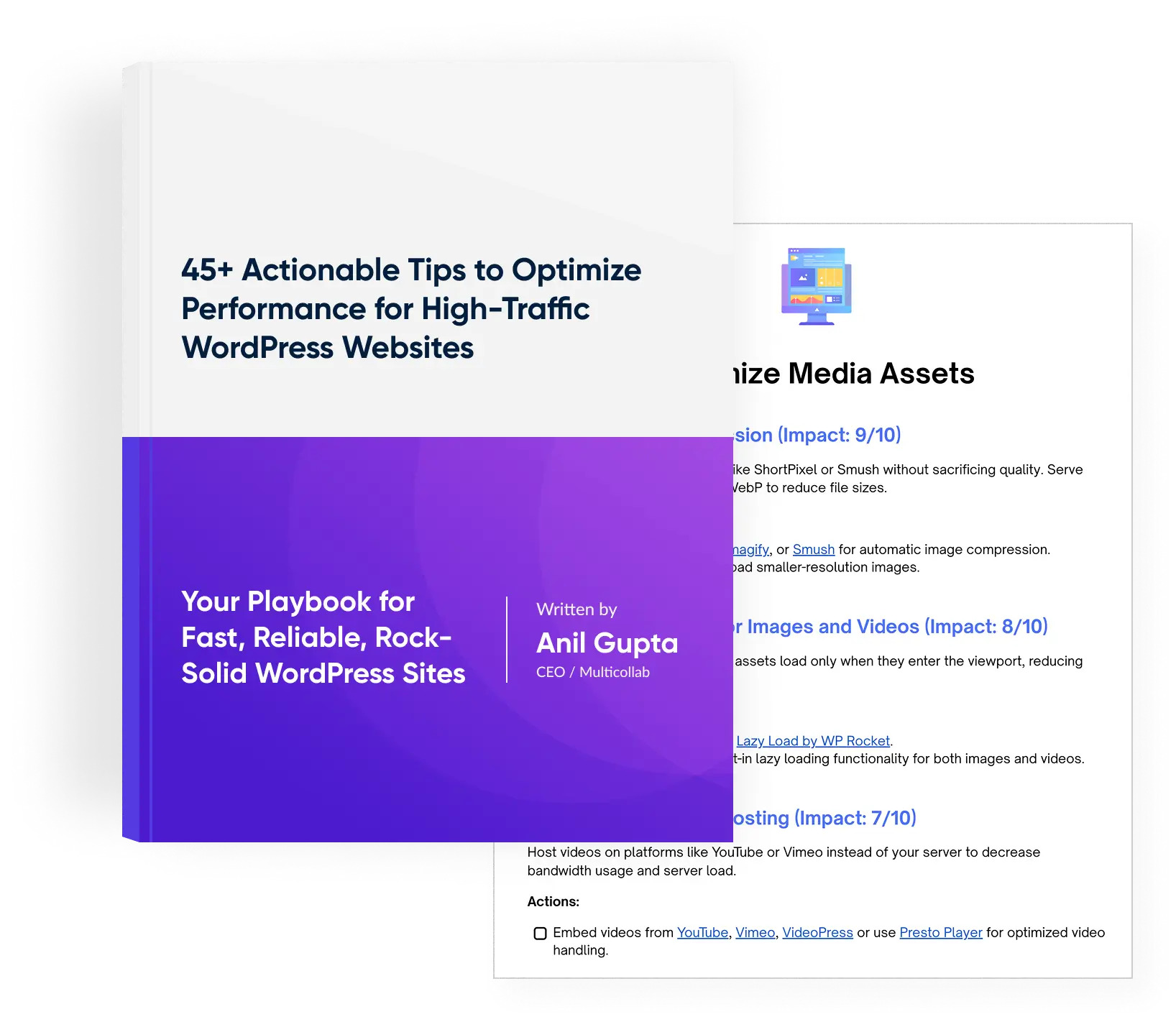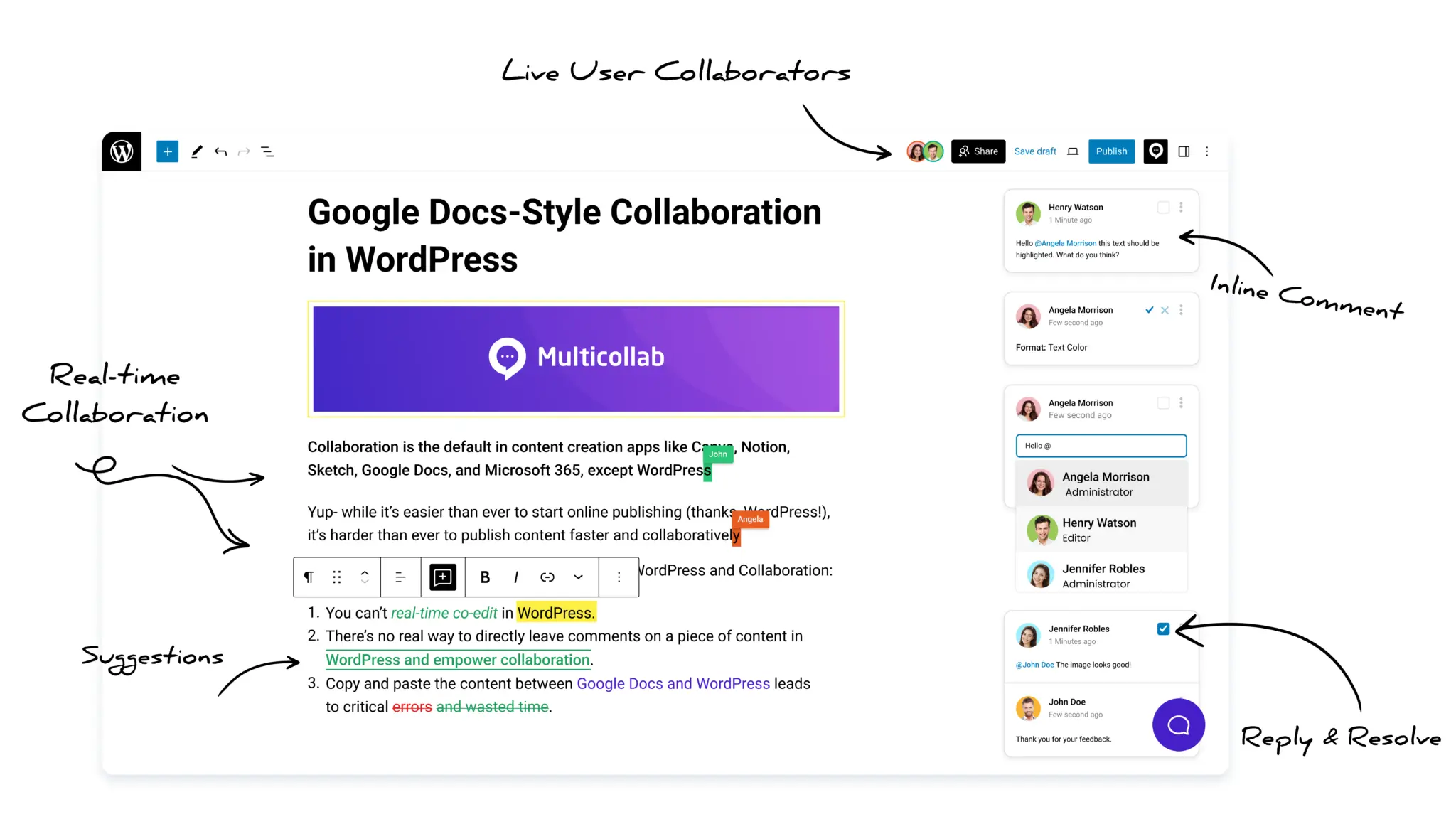Table of Contents
You’re part of a WordPress content team working on a big project with a tight deadline. You’ve got multiple editors, writers, and stakeholders, so you’d think things would move fast. But instead, feedback comes in randomly—sometimes through email, other times in chat, or even during meetings. Revisions seem endless, and the content keeps getting stuck. Sound familiar? The result? Delays, frustration, and inconsistent quality.
Now, in a different scenario where feedback is organized, structured, and everyone is on the same page-comments are clear, edits are made in real-time, and revisions are completed efficiently. This is where the power of a collaborative feedback loop shines through.
Collaborative feedback loops provide a clear path for content revisions, making communication smoother and speeding up the approval process. In this blog, we’ll explore how WordPress content teams can easily implement these loops using tools like Multicollab, a powerful plugin designed to boost productivity and streamline collaboration.
What are collaborative feedback loops?
Collaborative feedback loops are all about giving and receiving feedback while a project is still in progress-whether it’s a blog post, design, or something else. Instead of waiting until the end to make changes, feedback is shared continuously, creating an ongoing cycle of improvements.
Here’s how it works:
Team members give, receive, and act on feedback regularly, helping shape the project in real time.
This ongoing collaboration allows everyone—writers, editors, designers, and even stakeholders—to weigh in and improve the final product.
By using feedback loops, teams avoid miscommunication and speed up the revision process.
Take a WordPress content team, for example. Writers submit drafts, editors leave comments, and stakeholders suggest changes. The process repeats until the content is polished and ready to go.
Tools like Multicollab make this super easy by offering features like real-time collaboration, inline comments, and suggestion mode—all right inside WordPress. These features together help keep the feedback loop running smoothly.
Step-by-step: Setting up collaborative feedback loops in WordPress
Now that you get why collaborative feedback loops are so important, let’s break down how to actually set them up in your WordPress workflow. Here’s a simple guide:
Assign roles and permissions
First things first, clearly define who’s doing what. WordPress lets you assign specific user roles like editor, author, and contributor, which makes it easy to manage who’s giving feedback and who’s making changes. Having structured roles ensures your feedback sessions stay organized and productive.
Use real-time collaboration tools
Get a tool like Multicollab integrated right into WordPress. With Multicollab, your team can leave inline comments, suggest changes, and approve edits without ever leaving the WordPress dashboard. This keeps everything centralized, so no feedback gets lost in a random email thread.
Create a structured feedback framework
Set clear stages for feedback. Start with a draft review, then move on to more specific areas like SEO optimization, fact-checking, and finally, an editorial review. A structured feedback framework helps prevent overwhelming your content creators and keeps the process moving smoothly.
Set timelines for feedback loops
One of the biggest issues with feedback loops is delay. Set clear deadlines for when feedback should be provided. This keeps projects moving and helps avoid bottlenecks, ensuring revisions happen efficiently.
Key components of an effective collaborative feedback loop
Specific and actionable feedback
Imagine getting feedback like, “This part needs work.” Now, compare that to, “In this section, try adding a stronger call to action to engage the reader.” Which one is more helpful? The second one, obviously.
For collaborative feedback to work, it needs to be specific and actionable. Vague comments just cause confusion, while clear and direct suggestions push the content forward. Multicollab’s inline comments make it easy for team members to leave precise feedback directly on specific parts of the content, so there’s no guessing.
Real-time feedback for faster revisions
Time is of the essence, especially when you are working on multiple pieces of content simultaneously. Delays in feedback can bring everything to a halt. Real-time collaboration is the key to keeping things moving quickly.
With Multicollab’s real-time features, team members can leave feedback and make edits without interrupting the flow. Think of it as a live feedback session, but instead of everyone gathering in a meeting room, it all happens right in the WordPress dashboard. Quick, seamless, and super efficient.
Guest collaboration
Sometimes external contributors—like clients, guest authors, or freelance editors—need to be part of the feedback loop. But managing their input can be tricky if they don’t have full access to your platform.
Multicollab simplifies this by allowing guest collaboration without needing to give them full WordPress access. This way, stakeholders can still provide their input, without causing workflow disruptions.
Implementing collaborative feedback loops in WordPress: a step-by-step guide
Now that we’ve covered the basics, here’s a step-by-step guide to implementing collaborative feedback loops for your WordPress team:
Step 1: Define roles and expectations
Before feedback even starts, be sure to clarify who’s involved and what they’ll focus on. Are some team members responsible for stylistic feedback, while others handle fact-checking? Establish a clear feedback framework so everyone knows their role.
When feedback is received, one should ensure it aligns with the content’s goals and is actionable. This way, the person responsible for revisions knows exactly what’s expected.
Step 2: Choose the right tools
Picking the right tools is key to making collaboration easy. WordPress content teams often juggle several platforms, but Multicollab stands out by offering features like inline comments, suggestion mode, and activity tracking all within WordPress. This integration keeps everyone focused on the content without switching between tools.

Step 3: Encourage real-time feedback sessions
Set up real-time feedback sessions to speed things up and accelerate content creation workflow. Instead of waiting for feedback to trickle in through email or chat, editors and writers can collaborate instantly with live comments.
For instance, during a tight deadline for a product launch blog, the marketing team used Multicollab’s live feedback feature to make immediate changes. What could’ve taken days was wrapped up in hours, with everyone aligned on revisions.
Step 4: Monitor and optimize the feedback process
To keep improving your feedback loops, monitor how they’re working. Multicollab’s activity tracking lets you see feedback history and spot potential bottlenecks.
For example, if certain revisions are consistently delayed, take a look at the process to see whether clearer feedback could speed things up. This is where a collaboration performance review comes in handy. Regularly evaluate your feedback loops to ensure they stay efficient and goal-oriented.
Best practices for managing collaborative feedback
Setting up feedback loops is great, but managing them effectively is key. Here are some best practices for keeping your feedback sessions smooth and productive:
Keep feedback constructive and actionable: When feedback is received, one should make sure it’s clear and actionable. Instead of vague comments like “This doesn’t sound right,” aim for specific suggestions like “Consider rewording this sentence for clarity.”
Prioritize feedback: Not all feedback is equally important. During feedback sessions, tackle the most critical changes first, then move on to smaller stylistic tweaks.
Use feedback history to avoid redundancy: Multicollab allows you to track who gave feedback, when it was provided, and whether it’s been implemented. This avoids repetitive comments and keeps things moving.
Encourage open communication: Collaborative feedback is a two-way street. Make sure everyone on the team feels comfortable giving and receiving feedback. A healthy feedback culture benefits both the content and the team.
Handling feedback across multiple channels
A major challenge for WordPress teams is juggling feedback from multiple sources—emails, chats, meetings, you name it. This can lead to confusion and disorganized revisions. To avoid this, centralize all feedback in one place.
Centralize feedback in WordPress: Multicollab allows you to keep all feedback within WordPress itself, so you don’t need to bounce between email and chat. Integrating with Slack or email notifications also ensures team members stay updated without needing multiple tools.
Keep feedback organized: Whether it’s inline comments or larger suggestions, make sure feedback is grouped by priority and organized logically (e.g., by section or topic). This way, your team can address each point systematically.
Reviewing and measuring the success of feedback loops
A successful feedback loop isn’t just about completing the task—it’s about improving the process over time. Here’s how you can measure and review the success of your feedback loops:
Conduct collaboration performance reviews
After each project, review how well the feedback process worked. Was communication smooth? Was the feedback actionable? Did the team complete revisions on time? Performance reviews help you fine-tune the process for future projects.
Track time spent in revisions
Are your feedback loops speeding up or slowing down the project? Tracking revision time helps you measure efficiency. Multicollab provides activity reports, letting you optimize your feedback strategy.
Monitor content quality improvements
Finally, assess how feedback is affecting the content itself. Are the improvements noticeable? Are clients or stakeholders happier with the results? These are clear signs that your feedback loops are making a real difference.
Conclusion: Start implementing collaborative feedback loops today
Collaborative feedback loops aren’t just about managing revisions—they’re a powerful way to boost team efficiency, improve communication, and enhance content quality. By setting up structured feedback processes in WordPress, your team can ensure every voice is heard, feedback is centralized, and revisions happen in real time, minimizing delays and confusion.
Tools like Multicollab integrate seamlessly with WordPress, allowing teams to collaborate effortlessly. From inline comments and suggestion mode to real-time collaboration, these features keep your feedback loop tight and efficient.
Ready to streamline your content revision process? Start implementing collaborative feedback loops with Multicollab today and experience the transformation in how your team collaborates, creates, and succeeds.







